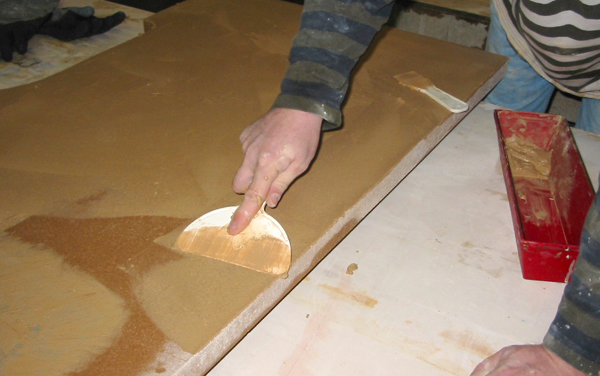Wow we must have all ascended to concrete mastery. Gees Corey what a stupid question. Slurry plays a key role in constructing concrete structures such as walls, as well as decorative elements such as birdbaths and benches.
Its smooth, thick texture allows it to fill minute holes and pits in a structure, creating a smooth surface for binding layers of concrete. However, while the counters are unmolding, small air bubbles can form, creating holes in your counter tops. Our students created a top that would require a concrete slurry to complete. Next step for me is the wet polishing.
I first wanted to know what makes a slurry ? Any help would be amazing! We sell a pre-made slurry mix on our. SureCrete is happy to announce the availability of the Xtreme Series concrete counter-top Slurry Mix. When making a countertop piece that has a sink in it, a knockout is needed to make a void in the concrete for the sink to fit in. There are types of sinks: Drop-In Sinks: The sink is placed into the countertop from on top, and rests on the concrete.
I think it looks amazing (and I will definitely have to do some sort of project soon that looks like that) but obviously for countertops , we need to make them smooth. To do that, we mix up a slurry of bone paste (really fine concrete ) and pigment and push it into the voids. Many exposed concrete building have bug holes on the face which adds texture. On your countertop the bug holes just hold food and are impossible to clean.
The only way to fix bug holes is to slurry. My white concrete desk shown below had lots of glass bottles seeded into the surface. Making your own concrete countertop is one of the more challenging—and rewarding—DIY projects. If you’re a rookie, keep your goals simple.
Plan for basic color treatments and plain edges, and also plan to spend a few weekends on the project. To slurry is to fill any voids and pinholes that remain from the casting or spraying process. Make your dry mix, if the aggregate is fine enough such as 1minus glass or 1mesh sand or Silica Flour divide it into two containers.
Coloring: If coloring the slurry , mix the color into the slurry in the same ratio as was used on the concrete mix. Make a template of the existing countertops out of 2½-inch-wide strips of ¼-inch plywood. White Cement Slurry Fill mix for countertops. Finishing concrete countertops without any pin holes requires mixing up a batch of slurry from your concrete mix (cement and water). This slurry can be about the texture of pancake batter.

Cover the entire surface area of the countertop with this slurry , filling in all the pin holes. Install the concrete countertops. Move the concrete countertops using a dolly. This will help tremendously, since two inch thick concrete countertops weigh about pounds per square foot. Lift and slide the countertops in place.
Then check to make sure they are level and shim if necessary. Apply 1 silicon to the base. Josh, there are many different ways to make concrete countertops. But yes, countertops can be made simply using the concrete mix itself.

DCI PRODUCTS AVAILABLE FOR CONSTRUCTING CONCRETE COUNTERTOPS Page 1. Calculate for a reserve for a slurry if needed. Thank you for taking the time to tell your story. When constructing a concrete countertop, be sure to use concrete mix that made for countertops , such as Quikrete Countertop Mix.
Start by building a form using melamine coated sheets goods, to prevent the concrete from sticking to the form. This basic mix has only ingredients you need to make a great concrete countertop. Concrete Countertop De-molding and Cleaning. After all, concrete is made up of the same material found in sidewalks.
Does the thought of a hairline fracture make you cringe? Follow these step-by-step instructions to make your own decorative concrete countertops. About pinholes and voids, which always happen. I was watching a guy making little glass scuptures. Just glass tubes, special gloves and a and one of those inexpensive propane things you can get at any tool store.
Yes, color hardener can be used to make a slurry for coloring vertical surfaces. This process is most often used when facing the front of steps or the vertical edges of stamped concrete slabs. An advantage of this method is that you can color the vertical sections as time permits, even days later if necessary.
Now the DIY concrete countertops will dry overnight and they will be ready for the sealer! High-flow formula minimizes the need for mechanical vibration.
No comments:
Post a Comment
Note: Only a member of this blog may post a comment.